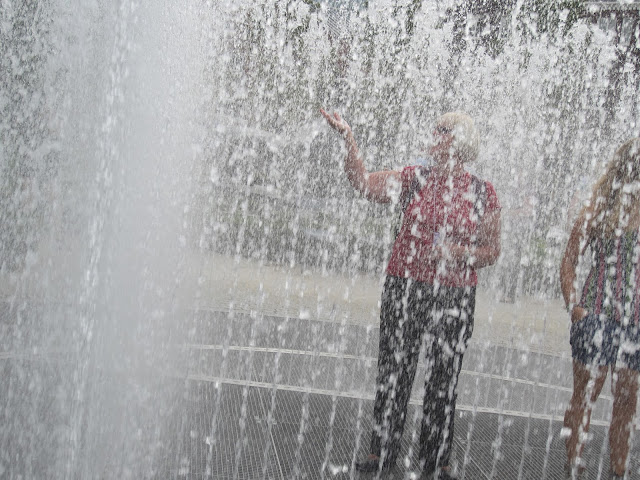Friday, March 7, 2014
The Outdoor Gardens of the Rijksmuseum
As we left the museum, our paths took us through the relaxing Rijksmuseum garden, also restored with an eye to Cuypers' original vision. It features statues, fountains, ponds, and five centuries of Dutch architectural artifacts.
Sam hopped into the middle of this fountain--and escaped without a drop.
Sculptures by Henry Moore (1898-1986), one of the most influential artists of the 20th century, are featured in the gardens. His monumental figures seem abstract, yet are clearly inspired by natural forms. On Moore's walks across the rolling English countryside, he would often collect animal bones which he sometimes literally transformed into sculptures.
A key theme in Moore's oeuvre is the reclining figure, in which the human body acquires a landscape-like quality. He tried to express--in stone or bronze--the energy he felt in nature: "I would like to think my sculpture has a vitality from inside it."
For example, his "Reclining Woman: Elbow" (above) was placed at the main entrance of the Leeds (England) City Art Gallery in 1982. Detractors complained: "Puzzling, suggestive, ridiculous, and diabolical," the Yorkshire Post commented. But that changed. When the sculpture was removed to be shown at the Rijksmuseum, the newspaper wrote, "You'll miss her when she's gone."
The sensual curves of the "Two Piece Reclining Figure: Cut" are interrupted by the incision in the center. Yet this also creates space, like the eye at the top (not visible in this photo), through which the sky appears. These hollows are typical of Moore's exploration of the sculpture's connection with its environment.
Henry Moore isn't the only sculptor featured in these gardens. "Mercury and Psyche" is a copy of a famous work by Adriaen de Vries now in the Louvre. De Vries worked at Giambologna's studio in Italy and for Emperor Rudolf II in Prague. As a result, he enjoyed considerable fame abroad, while remaining relatively obscure in the Netherlands. This copy was commissioned in 1890 for the Rijksmuseum garden.
I was also fascinated with this beautiful "street art" displayed in a shallow pond stretching out in front of the museum. We wandered around the neighborhood after leaving the museum, looking for a pastry shop my friend asked me to locate. We gave up after about 30 minutes and ended up at a souvenir shop where we bought some t-shirts. Then it was time for some lunch.
Labels:
Amsterdam,
Art,
Artist,
Museum,
Sightseeing,
Street Scenes
Subscribe to:
Post Comments (Atom)






No comments:
Post a Comment